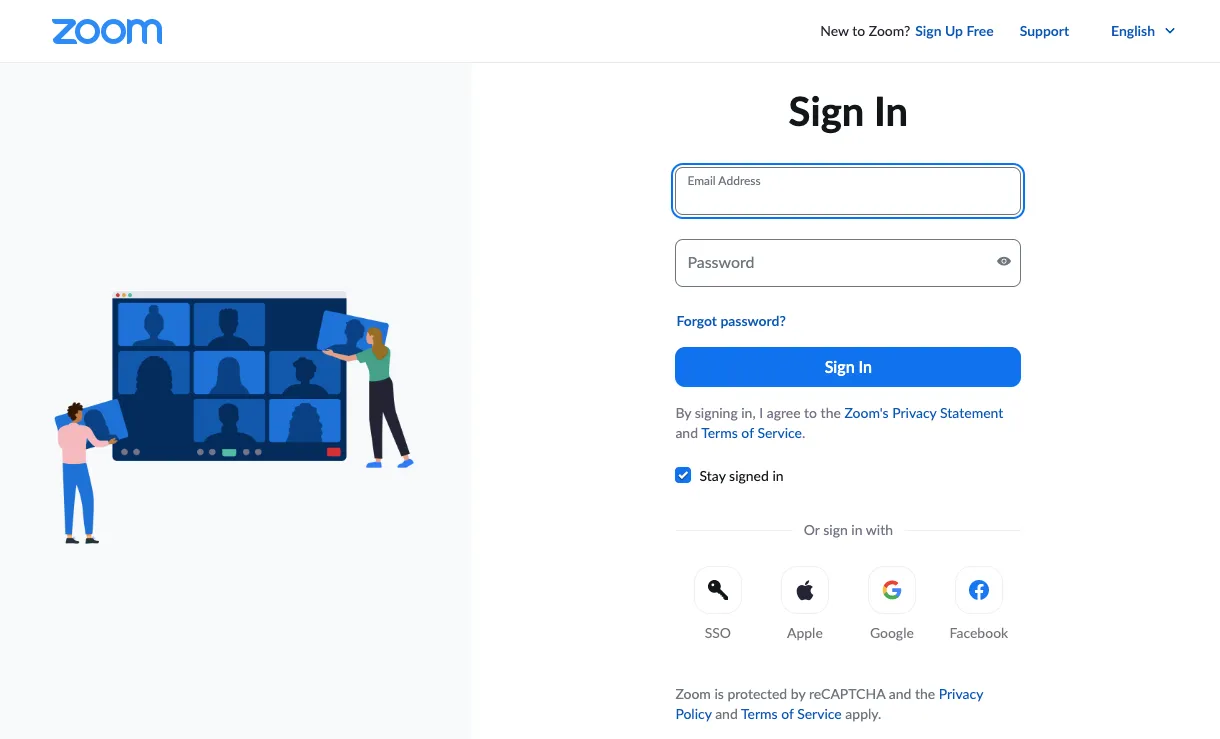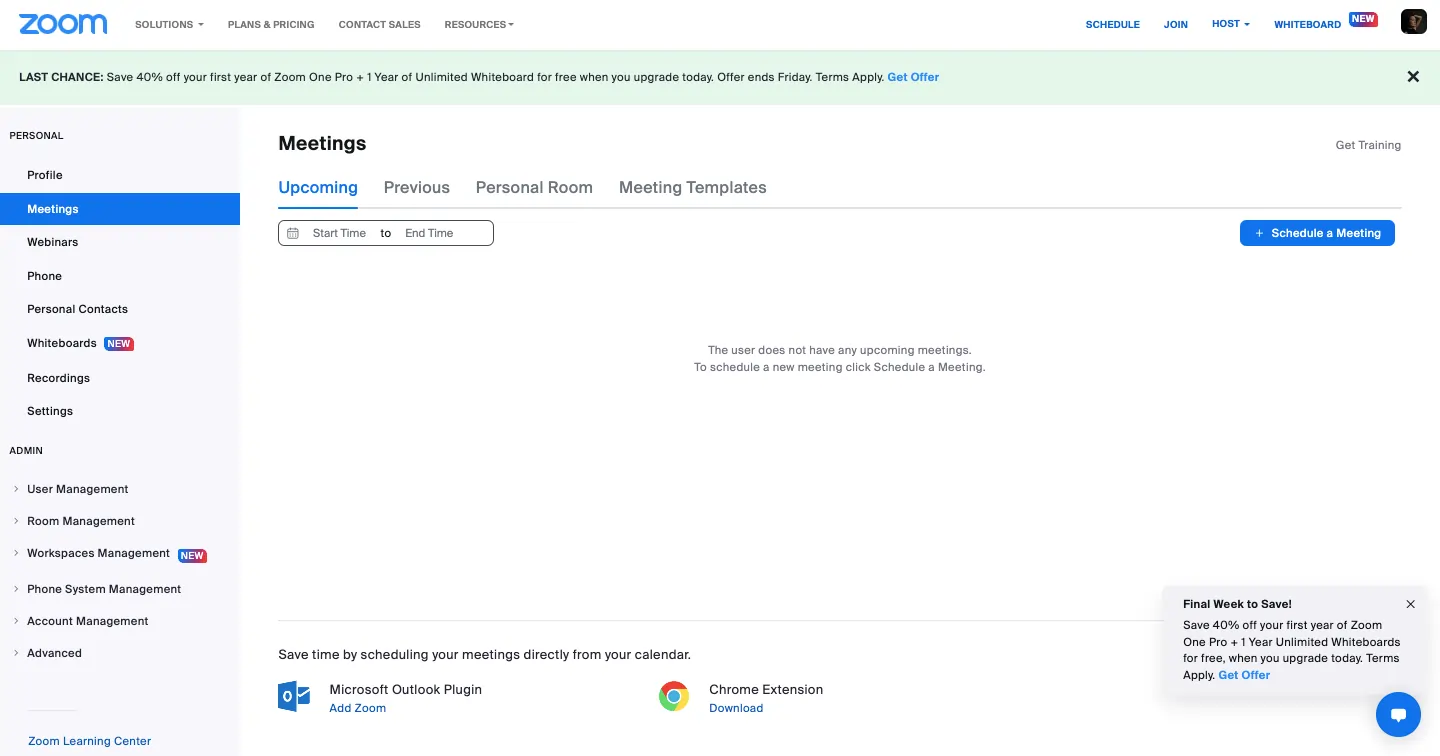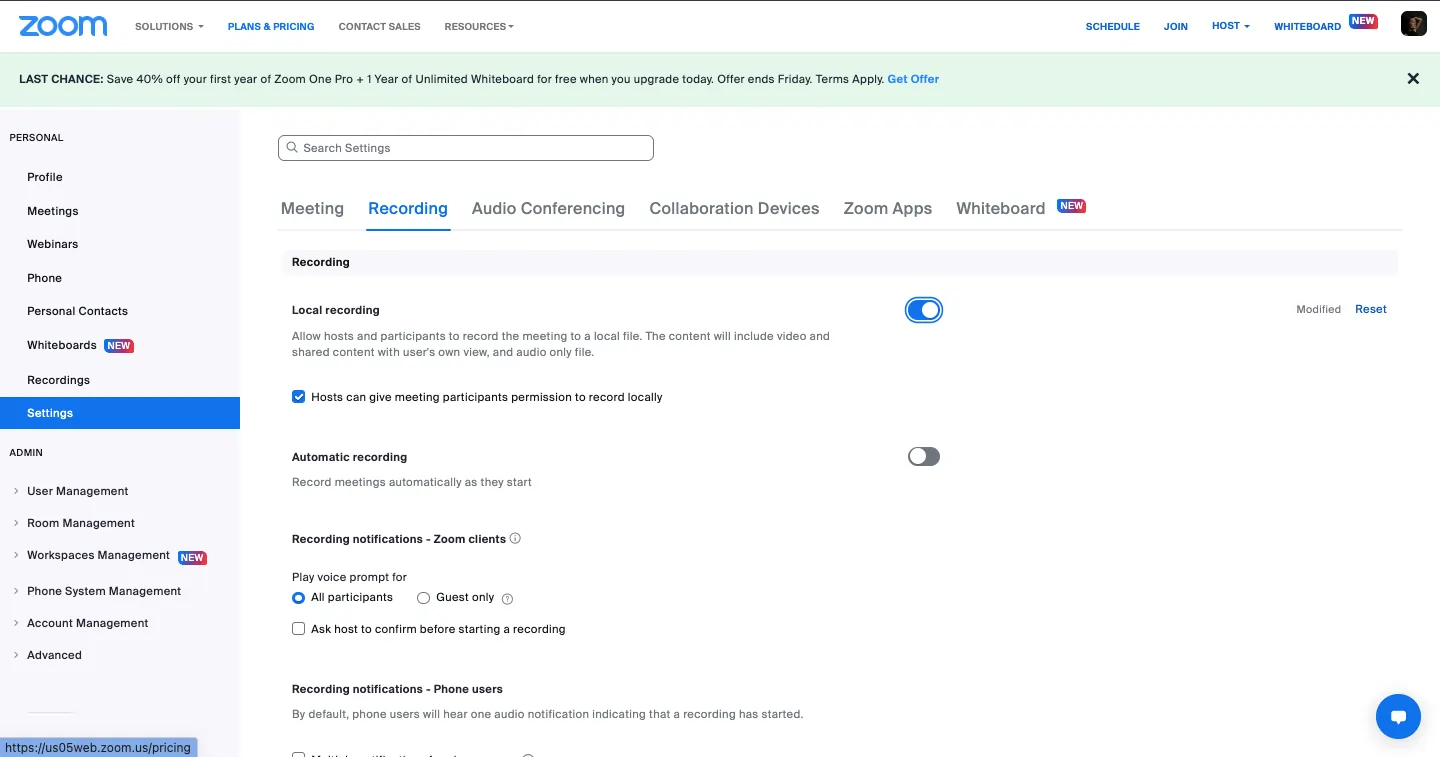Table of contents:
What does Zoom’s local recording mean?
Differences between Zoom local recording vs Zoom cloud recording
Requirements to enable local recording on Zoom
How to use Zoom local recording
Where are Zoom’s local recordings stored?
Limitations of Zoom local recording
Local recording should, in theory, give you the best quality remote recording possible. The fatal flaw of Zoom recordings is that you’re vulnerable to dodgy internet connection which can result in stuttery recordings or total disconnects. Local recording should remedy this completely. Unfortunately, Zoom’s local recording feature is not all that it might seem, and doesn’t quite fix this problem. In this article, we’ll explain why, how it works, and why you should consider alternatives such as Riverside that guarantee you proper local recording everytime.
TL;DR
- Recording locally means that Zoom will store your recordings on your computer, rather than on the cloud.
- You can’t record locally on iOS, iPad, or Android devices, you can only record to the cloud.
- Zoom local recordings are still captured and rely on internet connection
- Riverside’s local recordings are actually captured directly on your device and remain unaffected by internet connection.
What does Zoom’s local recording mean?
Local recording is a feature that’s available to all Zoom users, whether you’re on a free or paid plan. Although, note that Zoom local recording doesn’t work on iOS, iPad or Android devices.
But what does local recording actually mean on Zoom? According to Zoom support, local recording allows participants to record video and audio locally to their computer. A Zoom local recording reflects how you see the meeting - this means it records in the speaker view.
However, unlike local recording with Riverside, for example, your recording is only stored locally, rather than being automatically uploaded to the cloud. This means that your recordings aren’t directly captured on your device, they still are vulnerable to your internet connection. If your wifi is dodgy, your final recording will reflect this. Plus, when your recording is saved, Zoom automatically compresses your files, so you won’t be able to enjoy the full HD quality that local recording should give you.
Differences between Zoom local recording vs Zoom cloud recording
If you’re looking into local recording, it’s easy to get confused between Zoom local recording and Zoom cloud recording. Here’s a quick recap of the differences between them:
Zoom local vs cloud recording
Though they sound like different recording processes, zoom local and cloud recording are pretty much the same. This is because ‘local recordings’ with Zoom are still recorded in the online. The only difference, and what makes them ‘local’, is that your final recording is then downloaded locally to your device.
Zoom cloud recording works with the Zoom mobile app for iOS or Android. Once enabled, you can record to the cloud from your mobile device, and the recording will automatically apepar in your Zoom web portal once processed.
Local recording, on the other hand, is only available on desktop.
Which is better recording quality: cloud recording or local recording?
Given that local recording with Zoom is still cloud recording and therefore is still impacted by internet connection, there won’t be much difference between the cloud and local recording Zoom quality. The biggest factor will be that cloud recording is only available on mobile devices, whereas local recording only works when you’re using Zoom from a desktop.
Can I move a local zoom recording to the cloud?
Once your local recording has been processed and converted, you can do whatever you want with it. If you want to upload it to the cloud, simply login into a cloud storage platform such as Google Drive or DropBox and upload the file.
Requirements to enable local recording on Zoom
As we mentioned earlier, local recording is available to all users on a Basic (Free) account or above who are using the Zoom desktop app for Windows, MacOS or Linux. It’s unfortunately not possible to locally record using an iOS, iPad or Android device.
How to use Zoom local recording
Here’s a guide to using Zoom local recording:
Enabling local recording
Step 1: First, login to Zoom on your web browser. You need to be an administrator who can edit account settings.

Step 2: From the menu on the left, head to Personal>Settings

Step 3: Click on the 'Recording' tab and then enable 'Local Recording'. You may have to verify this change in your settings by hitting 'Enable' again. You can also click the Lock icon to make local recording a default setting for all the users associated with your Zoom account.

Starting a local recording
Step 1: Start a Zoom meeting and when everyone is ready, hit Record.
Step 2: If you see a menu, then click ‘Record on this Computer’. You will need to invite all your participants to do this if you want everyone to have a local recording.
Step 3: Once your meeting is finished, wait for Zoom to convert your recording.
How to find Zoom recordings
Step 1: Once your recording has been converted, Zoom should automatically open the file with your recording files.
Where are Zoom’s local recordings stored?
Once you’ve finished up with your Zoom meeting, naturally you’ll want to find your recording. Zoom places all your local recordings by default in the following directories:
- Windows: C:\Users\[Username]\Documents\Zoom
- Mac: /Users/[Username]/Documents/Zoom
How do I access my Zoom recordings
As we mentioned earlier, once you’ve wrapped up your meeting and your recording has been properly converted, Zoom should automatically open the folder with your converted file.
Note that local recordings are saved to the computer on which they were recorded. So, if you weren’t the person recording, you will need to ask that participant to send you over the file.
How can I change the default location for local recordings on Zoom?
Step 1: If you want to change the default location for Zoom local recordings, login to Zoom on your desktop.
Step 2: Head to Settings > Recordings > Local Recordings
Step 3: Click on ‘Change’ to manually change the default recording location
Limitations of Zoom local recording
Though local recording is, in theory, a great feature, Zoom doesn’t quite pull it off. Here are some of the main drawbacks:
No progressive upload
A major drawback of Zoom local recordings is that if your meeting shuts down unexpectedly for some reason or the conversion process is interrupted, you may lose all of your recording. If this happens, the files may be non-recoverable which leaves you with no recourse but to re-record.
Not saved to the cloud
Local recordings on Zoom are only saved on the device of the person recording. This creates huge inefficiencies in the recording and editing process, because you will need to ask your participants to manually send you over their recording.
No automatic multitrack (video) recording
If you want to record each participant’s audio onto a separate track, this is possible through Zoom though you’ll need to set this up manually. Separate audio tracks on Zoom is not an automatic feature.
However, multitrack video recording is not possible with Zoom. So, if you want a final recording that consists of each participant’s local video recording you will need to ask each of your guests to locally record themselves and combine each file into on. This will ultimately create a lot of work for you during post-production.
Not available on mobile or tablet
Another disadvantage is that you can’t locally record using your phone or tablet. For creators on the go, this might be frustrating - especially given that this is possible using platforms such as Riverside.
Cannot record shared screen, gallery view or active speaker
Zoom local recording doesn’t support recording the active speaker, gallery view or any shared screens.
Not compatible with audio transcripts
If you want a Zoom transcript when local recording, you’re going to be disappointed. Unfortunately, transcription isn’t compatible with local recording on Zoom.
“Riverside is far better than Zoom for recording interviews.” - Seth Godin, author, entrepreneur and marketing leader.
Riverside: An alternative to local recording on Zoom
Local recording is a great feature, but Zoom’s version of local recording doesn’t quite cut it. Riverside, on the other hand, has specialized in local recording from day one:
Automatic local recording
Riverside automatically records each participant’s video and audio directly on their devices. This local recording is completely unaffected by dodgy internet or cut connection, so the final video and audio will be the highest-quality possible.
Progressive upload to the cloud
Unlike Zoom which only saves the ‘local recording’ to that one participant’s device, Riverside progressively uploads each participant’s local recording to the cloud during your recording session. Not only does this reduce the amount of time you have to wait for your recording to process, but also minimizes the risk of data loss.
Mobile app
Local recording is available whether you’re using Riverside through your browser or through the mobile app.
High-quality recording & uncompressed files
Riverside defaults to high-quality recording. Your video can be up to 4K resolution for each participant and your audio will be crystal clear at up to 48kHz WAV, uncompressed.
Browser-based
Since Riverside is browser-based, you don’t need to download a specific application to get started.
Multitrack recording
In addition to locally recording all participants, Riverside also captures each persons audio on an individual separate track. This gives you invaluable control during post-production.
Available to all users
Just like Zoom, local recording is available to all Riverside users, whether you’re on a free or paid plan.
Transcriptions
You can easily create a transcript of your recording with Riverside with the automatic transcript generator.
Riverside vs Zoom local recordings
Here is a direct comparison of local recording with Zoom vs Riverside:
Riverside progressively uploads
Whilst Zoom processes your recording after you’ve wrapped up your session, Riverside uploads your recording progressively during your recording. This means there’s a minimal risk of data loss (compared to a significant chance with Zoom if something goes wrong) and you don’t need to wait around for your recording to process.
Riverside recordings are unaffected by internet connection
Though local recording should mean that your recording is immune to bad internet connection, this doesn’t seem to be the case with Zoom. Riverside, by contrast, guarantees that even with dodgy wifi your final recording will be unaffected.
Riverside defaults to simple & intuitive workflows
Since Riverside is tailor made to creators looking to record high-quality remote videos, its features and functionalities all work to make this possible. As such, the user experience with Riverside is intuitive and smooth. By comparison, Zoom is built to facilitate remote video calls, not necessarily to produce high-quality recordings or publication-ready videos. As such, it’s interface or workflows may feel illogical or clunky.
FAQs on Zoom Local Recordings:
Does Zoom save recordings locally?
If you record locally with Zoom, the recording will automatically be saved to that one device.
Does Zoom compress video?
Yes, Zoom defaults to the compressed and lossy file format mp4 and m4a.
How long does it take for Zoom recordings to show up?
For cloud recordings, the processing time will be roughly twice the duration of the duration of the recording. Be warned, however, that it can take up to 24 hours depending on the processing load.
Do Zoom recordings show all participants?
First of all, if you’re doing a cloud recording then only the participants names will show up.
For local recordings on your desktop, if you’re in active speaker view this means that the recording will only show the active speaker.
Can you retrieve a zoom meeting that was not recorded?
If you didn’t click record, it’s not possible to retrieve the meeting recording unfortunately.
Can you record a Zoom meeting if you are not the host?
If you want to locally record, you will need to ask the host to give you permission to record. They can do this by simply giving you permission to record or designating you as an alternative host.
Can you convert local Zoom recording files into MP4s?
Zoom local recordings save in MP4, m4A, M3U, TXT, CC.VTT and VTT formats anyway. So if you have an audio/video file, it should already be saved as M4a.















.webp)
---Riverside.webp)




